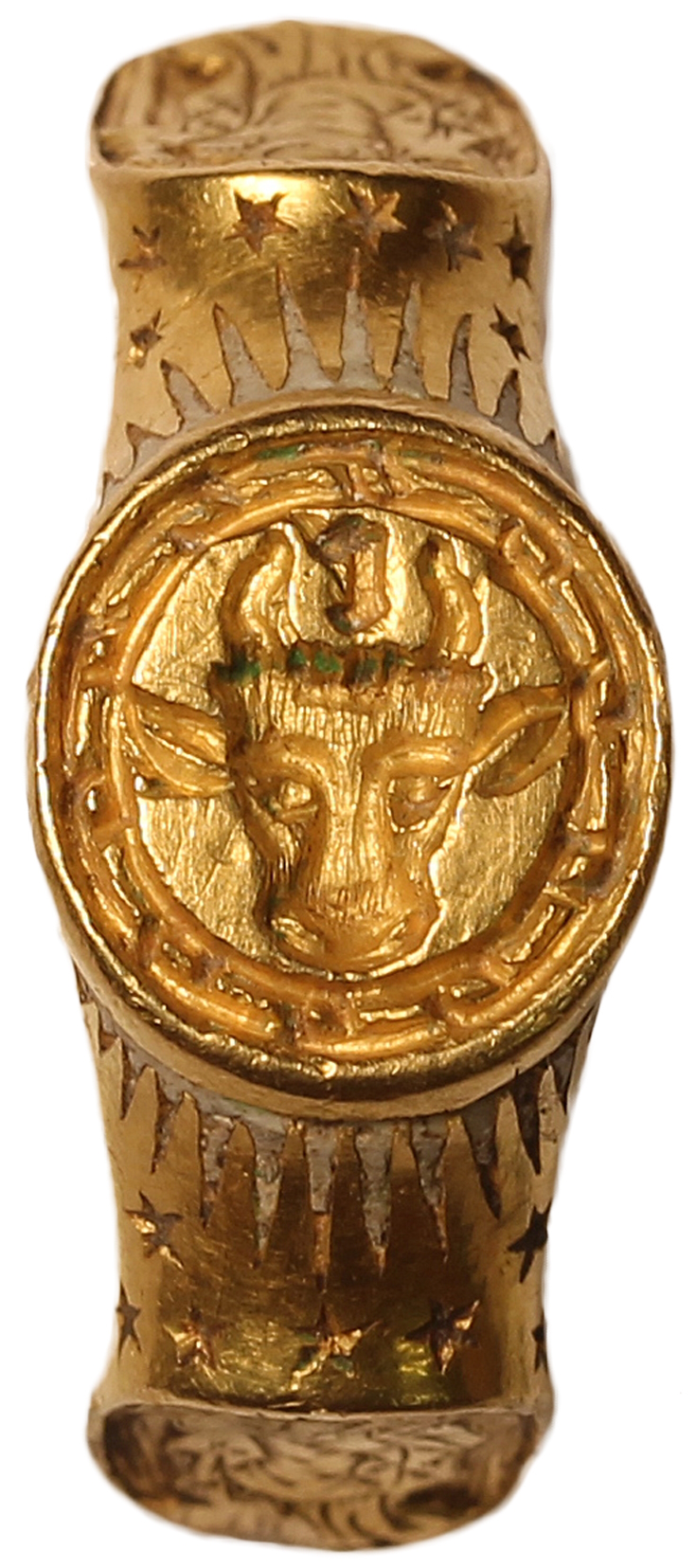Krása 👍
Detector finding of the Boleyn gold ring on display in Queen Anne Boleyn's Hall
Categories: Nálezy nejenom s detektorem ve Velké Británii a Irsku
The former royal palace of Hampton Court displayed a gold, enamelled Tudor seal ring, a favouritecourtiers and relatives of one of England's most famous queens, Anne Boleyn, wife of Henry VIII. and mother of Queen Elizabeth I.
The ring's setting is decorated with the head of a bull with large protruding ears and upward pointing horns, between which is a hardly recognizable letter. Perhaps an "e", "r" or "t". The white enamel filled sun rays 'shine' along with the stars on the sides, on which are flattened oval panels with religiousfigures - the Virgin Mary and Child on one side, St Catherine of Alexandria on the other, making the ring an unusual combination of personal and religious jewellery.
The ring has been analysed at the British Museum. According to experts, the design matches other early Tudor-era objects, leading them to believe it may have belonged to either Thomas or George Boleyn - the father and brother of Anne Boleyn. The heraldic bull's head is also found in the Boleyn family - for example, on the seal of a Thomas Boleyn document from this period. This is probably a common pun at the time, referring to the surname, which was often spelt 'Bullen'.
The location of the find may be another connection of the ring to the Boleyn family. The jewel was discovered in a field near Shurland Hall on the Isle of Sheppey, an island off the north coast of Kent about 70km east of Hever Castle - the seat of the Boleyn family. They had one of the largest estates in medieval Kent. The original 13th century castle was rebuilt between 1510 and 1518 by a relative and close friend of the Boleyns, a trusted courtier of Tudor monarchs from Henry VII to Elizabeth I, Mr Thomas Cheyne, who was also Sheriff of Kent, its Justice of the Peace, Privy Councillor and Ambassador to France.
Cheyne was particularly popular with Anne Boleyn, who successfully campaigned for his elevation. In October 1532 he was chosen to host the future royal couple and their large retinue. They spent three days at Shurland Hall on their way to Calais, where they sought the support of King Francis I of France for their marriage. Henry and Anne were secretly married a month later.
It is believed that the ring did not belong to Anne herself; the signet ring was primarily a typically male piece of jewelry that was simply too large for a woman. However, her father and brother - Thomas and George - both used (successively) the title of Viscount, so they were entitled to wear the monogram of Rochford. The ring contains an initial which could mark the letter R - further strengthening speculation as to its origin.
St Catherine is known for her scholarly defence of her faith, and the choice of saint may refer to Henry's first wife, Catherine of Aragon. There is a possibility that the ring may alternatively have belonged to another wealthy Tudor, although this does not change the fact that it is a remarkable and beautiful piece of jewellery from this period.
The ring was acquired by Historic Royal Palaces (HRP), a not-for-profit organisation that looks after Hampton Court Palace. It will be displayed in the Great Hall, which is at the heart of the surviving Tudor palace and was built to mark the King's wedding to Anne Boleyn, who herself was involved in its conception.
"We are thrilled to have acquired this rare Tudor gem for our collection and to be able to show it for the first time at Hampton Court this February.Portable Antiquities Scheme and our very generous donors," said Mr Sebastian Edwards, Deputy Chief Curator at Historic Royal Palaces. "This is a remarkable find that raises fascinating questions about who it may once have belonged to and how it may have been used in the Tudor court. We may never know for certain whether it was worn at Hampton Court by a member of the Boleyn family, but it is entirely appropriate that such a magnificent Tudor discovery can now be enjoyed by our many visitors who come to admire the books of King Henry VIII. and Queen Anne Boleyn in the Great Hall, which witnessed many momentous events during their reign," he added.
Roman Nemec
Sources: getsurrey.co.uk, thehistoryblog.com, hrp.org.uk

The bull ring refers to the Bolyen family

Profile

detail from the side

Anne Boleyn
The article is included in categories:
- Archive of articles > Archaeology > Finds and rescue research abroad > Nálezy nejenom s detektorem ve Velké Británii a Irsku
Post
No to je krasavec 
 Nádherný
Nádherný

Opravdu, krasavec. 👌👏
Děkuju všem.
A co říkáte na ten prsten?

Jó ten.No to byl asi úspěšný a vážený řezník nebo prodejce dobytka😂

Řeznickej se plácl přes kapsu. 
Krásná zlatnická práce.👍















